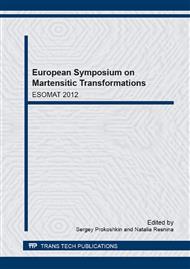p.46
p.51
p.56
p.65
p.72
p.77
p.82
p.87
p.92
High Temperature Martensitic Transformation and Shape Memory Behavior in Hfir Intermetallic Compound
Abstract:
The present paper is dedicated to the first observation of the martensitic transformation (MT) and associated shape memory effect (SME) in HfIr equiatomic intermetallic compound. Differential scanning calorimetry allowed determining MT temperatures, which are above 700 K. It was also shown that MT taking place at such high temperatures is associated with SME measured in 3 point bending. MT temperatures and crystal structure changes in the homogeneity range of HfIr compound were also studied. SME behavior changes in the homogeneity range of HfIr compound are discussed
Info:
Periodical:
Pages:
72-76
Citation:
Online since:
January 2013
Authors:
Price:
Сopyright:
© 2013 Trans Tech Publications Ltd. All Rights Reserved
Share:
Citation:


